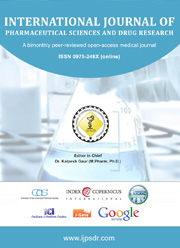DEVELOPMENT AND EVALUATION OF SOLID-LIPID NANO-PARTICLES OF SULFASALAZINE FOR ANTI- RHEUMATIC ACTIVITY
DOI:
https://doi.org/10.25004/IJPSDR.2024.160203Keywords:
Solid lipid nanoparticles, chitosan, sulfasalazine, rheumatoid arthritis, complete Freund's adjuvantAbstract
Chronic rheumatoid arthritis (RA) can cause irreversible joint deterioration over time. Solvent-based lipid nanoparticles (SLNs) are widely used as an efficient method to increase the oral bioavailability of poorly soluble medicines like Sulfasalazine. The present study aimed to formulate and evaluation of anti-rheumatic potential of the solid lipid nano-particles (SLNs) of Sulfasalazine. Drug loaded SLNs were formulated and coated with chitosan (CS) for sustained delivery and characterized for particle size, poly dispersity index and in vitro drug release. safety and efficacy profile of optimized batch was analyzed in animal model. Particle size of the optimized formulation was 269±2.45 nm with the PDI of 0.217±0.008 and entrapment efficiency of about 79.9±2.21. The zeta potential of particles was 35.7 mV. Particles had spherical shape with size ranging 100 nm which was determined by TEM analysis. Created formulation showed that the medication was released from the lipid matrix under regulated conditions, with 83.2±1.5% of the drug released in 24 h. Cmax for drug was higher (337±24) when administered as SLNs drug, similarly Tmax was longer when administered as lipid nanoparticles (6Hr), indicating a sustained drug release from SLNs. complete Freund's adjuvant (CFA) activity in rats administered with CS-SSZ-SLN (300mg/kg) equivalent to doses of 300mg/kg SSZ showed reduction in paw edema by day 9 (53.1 ± 1.75% (p<0.005), day 18 (68.68 ± 2.08%) (p<0.001) and 78.24 ± 2.36 % ( p<0.001) on day 21 respectively. Significant increase in the Tmax and the T1/2 values for the nanoparticles, indicates sustained release of the drugs by the SLNs. Sulfasalazine functions by decreasing inflammation, which is likely responsible for lessening the signs and symptoms of inflammatory diseases such rheumatoid arthritis and inflammatory bowel disease.
Downloads
References
Gibofsky A. Overview of epidemiology, pathophysiology, and diagnosis of rheumatoid arthritis. Am J Manag Care. 2012 Dec; 18(13):S295-302.
Taylor PC. A structured literature review of the burden of illness and unmet needs in patients with rheumatoid arthritis: a current perspective. Rheumatology Int. 2016; 36 (5): 685-95.
Parida JR, Misra DP, Wakhlu A, Agarwal V. Is non-biological treatment of rheumatoid arthritis as good as biologics? World J Orthop. 2015. 18; 6(2): 278-83.
Chandrashekara S, Patted A. Role of vitamin D supplementation in improving disease activity in rheumatoid arthritis: An exploratory study. Int J Rheum Dis. 2017; 20(7):825-831.
Guo Q, Wang Y, Xu D, Nossent J. Rheumatoid arthritis: pathological mechanisms and modern pharmacologic therapies. Bone Res. 2018 Apr 27;6:15.
McInnes IB, Schett G. Pathogenetic insights from the treatment of rheumatoid arthritis. Lancet. 2017 Jun 10;389(10086):2328-2337
Emery P. Treatment of rheumatoid arthritis. BMJ. 2006 Jan 21; 332(7534):152-5.
Friedman B, Cronstein B. Methotrexate mechanism in treatment of rheumatoid arthritis. Joint Bone Spine. 2019 May; 86(3):301-307
Buch MH, Eyre S, McGonagle D. Persistent inflammatory and non-inflammatory mechanisms in refractory rheumatoid arthritis. Nat Rev Rheumatol. 2021; 17:17–33.
Nagy G, Roodenrijs NMT, Welsing PM, Kedves M, Hamar A. EULAR definition of difficult-to-treat rheumatoid arthritis. Ann Rheum Dis. 2021; 80:31–5.
Agarwal SK. Core management principles in rheumatoid arthritis to help guide managed care professionals. J Manag Care Pharm. 2011; 17(9 Suppl B):S03-8.
Moura M, Lopes L, Silva MT. Use of steroid and nonsteroidal anti-inflammatory in the treatment of rheumatoid arthritis: Systematic review protocol. Medicine (Baltimore). 2018 Oct; 97(41):e12658.
Van den Bemt BJ, Zwikker HE, van den Ende CH. Medication adherence in patients with rheumatoid arthritis: a critical appraisal of the existing literature. Expert Rev Clin Immunol. 2012 May; 8(4):337-51.
Movahedi M, Beauchamp ME. Risk of Incident Diabetes Mellitus Associated With the Dosage and Duration of Oral Glucocorticoid Therapy in Patients With Rheumatoid Arthritis. Arthritis Rheumatol. 2016 May; 68(5):1089-98.
Senolt L, Vencovsky J. Prospective new biological therapies for rheumatoid arthritis, Autoimmunity Reviews. Autoimmunity Reviews. 2009; 9(2): 102-107
Mrid RB, Bouchmaa N, Ainani H. Anti-rheumatoid drugs advancements: New insights into the molecular treatment of rheumatoid arthritis. Biomedicine & Pharmacotherapy. 2022; 151:113-126
Logesh K, Raj B, Bhaskaran M. Nanoparticulate drug delivery systems for the treatment of rheumatoid arthritis: A comprehensive review. Journal of Drug Delivery Science and Technology. 2023; 81:104-109
Mukherjee S, Ray S, Thakur RS. Solid lipid nanoparticles: a modern formulation approach in drug delivery system. Indian J Pharm Sci. 2009 Jul; 71(4):349-58.
Ghasemiyeh P, Mohammadi-Samani S. Solid lipid nanoparticles and nanostructured lipid carriers as novel drug delivery systems: applications, advantages and disadvantages. Res Pharm Sci. 2018 Aug; 13(4):288-303.
Mishra V, Bansal KK, Verma A, Yadav N, Thakur S. Solid Lipid Nanoparticles: Emerging Colloidal Nano Drug Delivery Systems. Pharmaceutics. 2018 Oct 18; 10(4):191.
Uner M, Yener G. Importance of solid lipid nanoparticles (SLN) in various administration routes and future perspectives. Int J Nanomedicine. 2007; 2(3):289-300
Behzadi S, Serpooshan V et al. Cellular uptake of nanoparticles: journey inside the cell. Chem Soc Rev. 2017 Jul 17; 46(14):4218-4244
Mehnert W, Mäder K. Solid lipid nanoparticles: production, characterization and applications. Adv Drug Deliv Rev. 2001 Apr 25; 47(2-3):165-96
Rizvi SAA, Saleh AM. Applications of nanoparticle systems in drug delivery technology. Saudi Pharm J. 2018 Jan; 26(1):64-70
Egusquiaguirre SP, Igartua M, Pedraz JL. Nanoparticle delivery systems for cancer therapy: advances in clinical and preclinical research. Clin Transl Oncol. 2012; 14(2):83-93.
Doktorovova S, Souto EB, Silva AM. Nanotoxicology applied to solid lipid nanoparticles and nanostructured lipid carriers - a systematic review of in vitro data. Eur J Pharm Biopharm. 2014 May; 87(1):1-18
Chinedu E, Arome D, Ameh FS. A new method for determining acute toxicity in animal models. Toxicol Int. 2013 Sept; 20(3):224-6.
Mikusova V, Mikus P. Advances in Chitosan-Based Nanoparticles for Drug Delivery. Int J Mol Sci. 2021 Sept ; 22(17):9652.
Sun D, Lu ZR. Structure and Function of Cationic and Ionizable Lipids for Nucleic Acid Delivery. Pharm Res. 2023; 40(1):27-46.
Guerini M, Condro G, Perugini P. Evaluation of the Mucoadhesive Properties of Chitosan-Based Microstructured Lipid Carrier. Pharmaceutics. 2022; 14(1):170.
Downloads
Published
Issue
Section
License
Copyright (c) 2024 Shikha Upadhyay Shikha

This work is licensed under a Creative Commons Attribution 4.0 International License.


